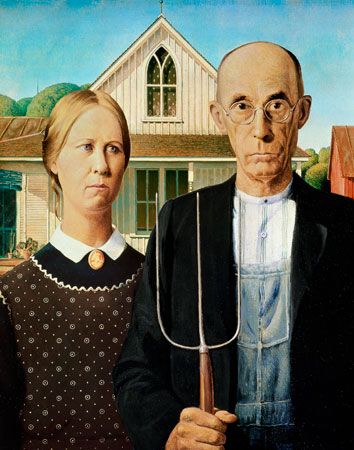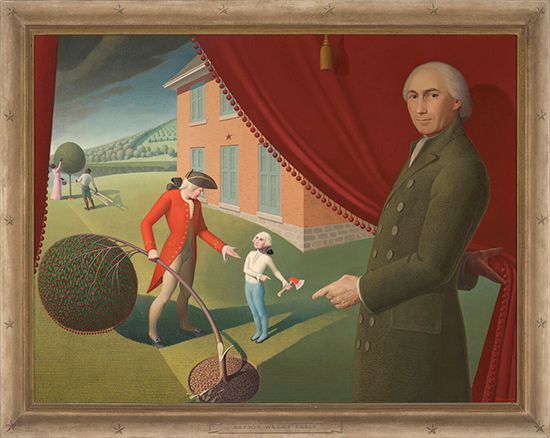Grant Wood
Our editors will review what you’ve submitted and determine whether to revise the article.
- Born:
- February 13, 1891, near Anamosa, Iowa, U.S.
- Notable Works:
- “American Gothic”
- “Daughters of Revolution”
- “Woman with Plants”
- Movement / Style:
- Social Realism
Grant Wood (born February 13, 1891, near Anamosa, Iowa, U.S.—died February 12, 1942, Iowa City, Iowa) was an American painter who was one of the major exponents of Midwestern Regionalism, a movement that flourished in the United States during the 1930s. He is best known for his American Gothic (1930).
Wood was trained as a craftsman and designer as well as a painter. After spending a year (1923) at the Académie Julian in Paris, he returned to Cedar Rapids, Iowa, where in 1927 he was commissioned to do a stained-glass window. Knowing little about stained glass, he went to Germany to seek craftsmen to assist him. While there he was deeply influenced by the sharply detailed paintings of various German and Flemish masters of the 16th century. Wood subsequently abandoned his Impressionist style and began to paint in the sharply detailed, realistic manner by which he is now known.
A portrait of his mother in this style, Woman with Plants (1929), did not attract attention, but in 1930 his American Gothic caused a sensation when it was exhibited at the Art Institute of Chicago. The hard, cold realism of this painting and the honest, direct, earthy quality of its subject were unusual in American art. The work ostensibly portrays a farmer and his daughter—modeled for Wood by his dentist, B.H. McKeeby, and Wood’s sister, Nan—in front of their farmhouse. As a telling portrait of the sober and hardworking rural dwellers of the Midwest, the painting has become one of the best-known icons of American art.

The meaning of American Gothic has been subjected to scrutiny since Wood painted it. Was it meant to be an homage to the strong values in the Midwest or was it a satire? Is it a husband and wife or a father and daughter? Wood’s own statements on its meaning were wishy-washy, leading to further ambiguity and debate. Open to so much interpretation, the American Gothic trope lent itself to countless parodies in popular culture as well as in the political arena, in advertisements, in television shows such as The Simpsons, in albums, in comic books, on magazine covers, and by Jim Henson’s Muppets.
Wood became one of the leading figures of the Regionalist movement. Another well-known painting by him is Daughters of Revolution (1932), a satirical portrait of three unattractive old women who appear smugly satisfied with their American Revolutionary ancestry.
In 1934 Wood was made assistant professor of fine arts at the University of Iowa, Iowa City. Among his other principal works are several paintings illustrating episodes from American history and a series of Midwestern rural landscapes that communicate a strong sense of American ambiance by means of a skillful simplification of form.



























